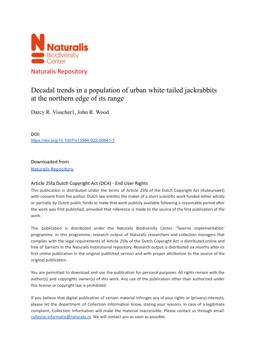2022-06-24
Decadal trends in a population of urban white-tailed jackrabbits at the northern edge of its range
Publication
Publication
Mammal Research , Volume 67 - Issue 4 p. 457- 465
The urbanization of environments is a major land use change across the globe that is expected to continue. While the urban environment typically presents wildlife with lethal challenges, it may also present new opportunities for species able to behaviourally adapt. White-tailed jackrabbits are a quintessential prairie adapted species, which are understudied and are suggested to be in decline across their range. In the frst urban study for this species, we surveyed the white-tailed jackrabbit population in Edmonton, Alberta, Canada. This population is at the northern edge of the distribution for this species. Using surveys conducted over a 24-year period across diferent land use strata, we show that the current average population density of white-tailed jackrabbits (8.0 hares/km2 ) is very similar to densities in their southern range and signifcantly higher than local rural populations. Our models suggest that the population is relatively stable and exhibits approximately 7-year cycles. We discuss the importance of upland city park habitats for this species and suggest further research to determine the spatial dynamics of the species in an urban setting. Given the dynamics of climate change, we highlight the importance of studying species at the leading edge of possible range expansion.
| Additional Metadata | |
|---|---|
| doi.org/10.1007/s13364-022-00641-7 | |
| Mammal Research | |
| Organisation | Staff publications |
|
Visscher, D., & Wood, John R. (2022). Decadal trends in a population of urban white-tailed jackrabbits at the northern edge of its range. Mammal Research, 67(4), 457–465. doi:10.1007/s13364-022-00641-7 |
|
